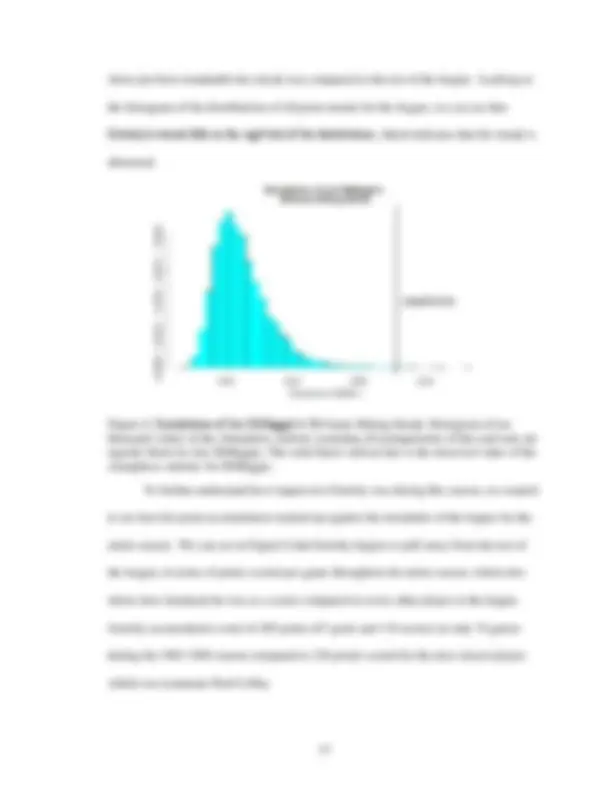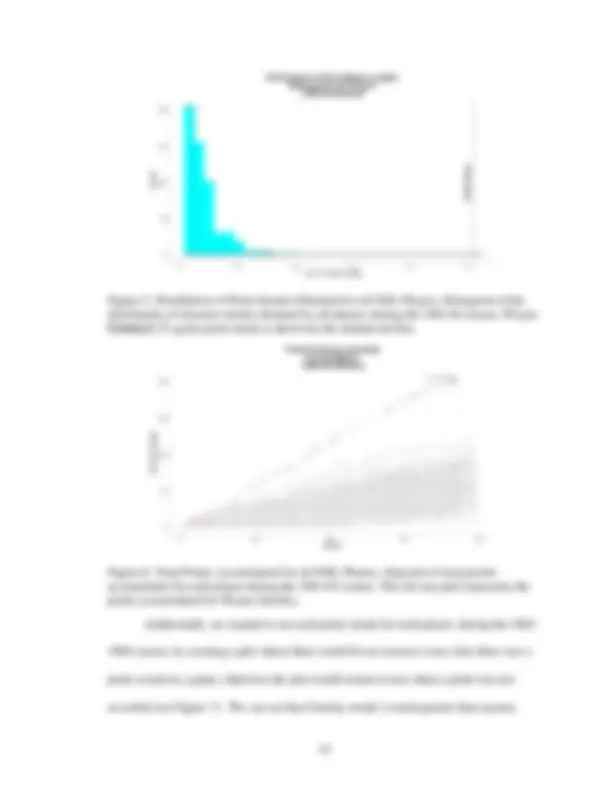































Study with the several resources on Docsity

Earn points by helping other students or get them with a premium plan


Prepare for your exams
Study with the several resources on Docsity

Earn points to download
Earn points by helping other students or get them with a premium plan
Community
Ask the community for help and clear up your study doubts
Discover the best universities in your country according to Docsity users
Free resources
Download our free guides on studying techniques, anxiety management strategies, and thesis advice from Docsity tutors
Wayne Gretzky's remarkable 51-game point streak during the 1983-1984 NHL season, where he recorded at least one goal or point in every game. The research uses game-by-game data for all players to evaluate and compare Gretzky's production and streak to the rest of the league, including simulations and visual representations. The document also discusses Joe DiMaggio's 56-game hitting streak for comparison.
Typology: Lecture notes
1 / 37

This page cannot be seen from the preview
Don't miss anything!






























Tyler Ison Submitted to the faculty of the University Graduate School in partial fulfillment of the requirements for the degree Master of Science in the Richard M. Fairbanks School of Biostatistics, Indiana University May 2019
ii Accepted by the Graduate Faculty of Indiana University, in partial fulfillment of the requirements for the degree of Master of Science. Master's Thesis Committee
William Fadel, PhD, Chair
Spencer Lourens, PhD
Ying Zhang, PhD
iv
To my parents (Scott and Holly Ison) and my siblings (Victoria and Elizabeth).
v
I would like to express my sincere gratitude to my advisor Dr. William Fadel for all of the guidance and support he provided throughout my project. I am truly grateful for all the help and instruction that you have provided me over the course of this work. I would also like to thank Dr. Spencer Lourens for the time and help with the data scraping that he attributed to me and my project. I would also like to thank Dr. John Boardman for all his encouragement, support and guidance throughout my time spent at Franklin College. Finally, I would like to thank my wonderful parents, Scott and Holly Ison, and my siblings, Victoria and Elizabeth, for their support throughout my entire academic career, and for their patience with me as I have been completing my degree. I could not have reached this point in my life without the guidance and support from all of you.
vii
List of Tables .................................................................................................................. viii List of Figures ................................................................................................................... ix List of Abbreviations ...........................................................................................................x Introduction .......................................................................................................................... 1 Methods................................................................................................................................ 5 Obtaining the Data ........................................................................................................ 5 Analysis.......................................................................................................................... 5 Results ................................................................................................................................ 10 Conclusion ......................................................................................................................... 17 Appendix A ........................................................................................................................ 20 References .......................................................................................................................... 26 Curriculum Vitae
viii
Table A.1: Wayne Gretzky’s Game-by-Game Breakdown ............................................... 20 Table A.2: Point Streaks Obtained by Wayne Gretzky ..................................................... 21 Table A.3: Scoring Droughts Obtained by Wayne Gretzky .............................................. 22 Table A.4: Joe DiMaggio’s Game-by-Game Breakdown.................................................. 23 Table A.5: Hitting Streaks Obtained by Joe DiMaggio ..................................................... 24 Table A.6: Hitting Slumps Obtained by Joe DiMaggio ..................................................... 25
x
NHL National Hockey League MLB Major League Baseball
Athletic sports have always had a fascinating connection with statistics, regardless of the sport. Different sports utilize different statistics to determine the likelihoods of different outcomes; as well as to evaluate the effectiveness and efficiency of individual player or team performances. Sports fans and statisticians tend to utilize sports specific statistics to dictate the success of a team or individual player over a season or their entire career; often comparing players across the same season, as well as different generations. Player and team success are often considered by investigating streakiness, also referred to as consistency, to determine overall efficiency for an entire season, career, or length of time. Streaks are difficult to measure, because there are no rules defining what constitutes a meaningful streak; in certain ways, a streak can be related to a degree of variation that exists in the data. However, streaks are important to show that binary outcomes in sports can, on occasion, defy expectation ( 1 ). Individual player performance and player streaks have more commonly been investigated in sports, such as baseball and golf. One of the most common sport streak investigations is Joe DiMaggio’s 56-game hitting streak, that he obtained during the 1941 MLB season. Many fans, experts, and critics believe this is a feat that will never be beaten. Some believe that it should have never happened at all ( 2 ). Numerous studies involving simulations have been conducted to test the probability or likelihood of a hitting streak of this length to be replicated, exceeded, or miraculously occur. Statistics have been used to investigate several other streaks within the game of baseball over the years. These include: Ted Williams’ 84-game on-base streak in 1949, Joe Sewell’s 115-
Ice hockey is a “stick-and-ball” game that developed from field hockey in the 1870s ( 4 ). It is considered the fastest paced and most violent team sport in the entire sports industry ( 5 ). It is a game that is often characterized by high intensity intermittent skating filled with quick changes in tempo and duration with excessive amounts of body contact ( 6 ). Each game is broken into three 20-minute periods, where players rotate on and off the ice in terms of shifts. These shift lengths vary depending on the player or game situation. Each team battles for puck control while trying to generate offensive advantages that lead to goals, and ultimately win the game. Hockey uses specific statistics known as Corsi and Fenwick statistics to determine how successful teams are, along with how efficient individual players are, throughout the season or in a given game. Jim Corsi, a former goaltending coach for the Buffalo Sabres, introduced the most advanced statistic in all of hockey ( 7 ). The Corsi statistic refers to all shots that are directed towards the goal regardless of whether it enters the net, gets blocked by the goalie or another skater, or misses the net completely ( 8 ). This advanced statistic is used to determine the impact that an individual player has on their team in any given game. The Fenwick statistic, created by Battle of Alberta writer Matt Fenwick, does not take into account blocked shots, simply because many believe blocking shots is a skill, rather than a series of random events ( 7 ). Unfortunately, these advanced statistics were not recorded until the early 2000s, thus resulting in the use of certain assumptions for our analysis. In 1983, one of the most remarkable accomplishments in the sports industry took place. Wayne Gretzky, of the Edmonton Oilers, scored a goal or recorded an assist in 51 consecutive games; a task that has yet to be matched. A point streak is commonly
defined as the number of consecutive games in which a player receives at least one goal scored or assist. Unlike many other streaks in sports, this streak lacks the recognition and investigation that it deserves. For the analysis of Gretzky’s streak, the current research will be looking at the entire 1983- 19 84 National Hockey League game-by-game data for each individual player and team obtained from NHL.com (9). Within this research, we will investigate the change in Gretzky’s scoring average over shorter lengths, as well as comparing his streak to the rest of the league and see how it relates. Due to the lack of advanced statistics being readily available, some assumptions must be made in order to perform a more in-depth analysis of interest. One major assumption is made when calculating the scoring average for Gretzky and every other skater in the League for the entire 1983- 19 84 season, which is that every assist that a player received were the only passes into the scoring zone that each player made. Due to the lack of shooting statistics and time on ice for each player, we cannot adequately calculate the Corsi or Fenwick statistics. Instead, research will rely on the assumption that is being made to perform an analysis. Analyzing the streakiness of a player, whether it be a positive streak or a slumping streak, can be done in two ways: find the longest slump or streak for a given player or run a simulation to predict a streak ( 10 ). Current research will investigate both of these methods in this paper to evaluate both the likelihood of this streak occurring and the comparison of Wayne Gretzky’s outstanding 51-game point streak during the 1983- 1984 NHL season.
is resulting in an assist. Underestimating the number of passing attempts results in a smaller denominator value than what we would actually expect to see, but with the limitations of the recorded data at the time of this streak, it is one that can be made to evaluate each players efficiency as a scorer or playmaker for their team since a player can receive a point by either scoring a goal or passing the puck to a player that scores a goal, or receiving an assist. Based on this assumption, the scoring average for Gretzky and all other players was calculated using equation 1. 𝑆𝑐𝑜𝑟𝑖𝑛𝑔 𝐴𝑣𝑒𝑟𝑎𝑔𝑒 = 𝑇𝑜𝑡𝑎𝑙 𝑃𝑜𝑖𝑛𝑡𝑠 𝑆𝑐𝑜𝑟𝑒𝑑 𝑇𝑜𝑡𝑎𝑙 𝑆ℎ𝑜𝑡𝑠 𝑇𝑎𝑘𝑒𝑛 + 𝑇𝑜𝑡𝑎𝑙 𝐴𝑠𝑠𝑖𝑠𝑡𝑠 A point streak is commonly defined as the number of consecutive games in which a player records at least one point via goal or assist ( 12 ). In order to track the scoring streaks of each individual player, a binary variable was created to express whether a player received a point for a given game, where a player that recorded at least one point for the given game would receive a numerical value of 1 or receive a numerical value of 0 if a point was not recorded, which is represented in equation 2. 𝑓(𝑆𝑐𝑜𝑟𝑒) = {
Following the creation of the score binary variable, a string of 1s and 0s was created to visually show the games in which Wayne Gretzky received or did not receive a point. Equation 3 expresses how a variable was created to represent each game that a player participated in during the season in chronological order as a running sequence – 𝑥 (^1) 𝑖 , 𝑥 (^2) 𝑖 , … , 𝑥𝑛𝑖 , where 𝑥𝑛 is the number of the played game for each player, i. 𝐺𝑎𝑚𝑒 𝑁𝑢𝑚𝑏𝑒𝑟 = (𝑥𝑛𝑖 ) 1 𝑛𝑖 Streak lengths were computed to create a list of the tallied number of consecutive games where a point was recorded, as well as creating a similar list of the tallied number of
consecutive games in which a point was not recorded for Wayne Gretzky during the entire 1983-1984 season. An alternative way of investigating the streaky scoring performances of players is to use the scoring average, which is computed over short time intervals to visually represent the fluctuation of scoring efficiency throughout the entire season ( 12 ). In this analysis, we looked at repeatedly computing Wayne Gretzky’s scoring average every ten games to evaluate the fluctuation of his scoring productivity. A moving average function was created using equation 4, where ni represents the game of interest and w represents the window length. 𝑀𝑜𝑣𝑖𝑛𝑔 𝐴𝑣𝑒𝑟𝑎𝑔𝑒 = ∑ 𝑛 𝑛𝑖+(𝑤−^1 )𝑆𝑐𝑜𝑟𝑖𝑛𝑔 𝐴𝑣𝑒𝑟𝑎𝑔𝑒 𝑖 𝑤 The created moving average function was then applied the dataset to create a plot of Wayne Gretzky’s moving scoring average, measured every ten games, throughout the entire 1983-1984 season. In addition, we wanted to see the top scoring streaks for the entire league and see how those streaks compared to Gretzky’s, and we wanted to investigate the top scoring droughts for the entire league compared to Gretzky’s. Following the calculation of maximum scoring streak lengths for each individual player, a simulation was created to see whether Gretzky’s 51-game scoring streak was unusual or not by running ten thousand replications of the streakiness, or clumpiness, statistic to compute ten thousand values of the clumpiness measure of the simulation procedure (10, 12). 𝑆𝑢𝑚 𝑜𝑓 𝑆𝑞𝑢𝑎𝑟𝑒𝑠 𝑜𝑓 𝐺𝑎𝑝𝑠 = ∑ 𝑛 𝑖= 0 (𝑋𝑖 − 𝑋̅ )^2 In order to test the clumpiness statistic and determine whether Gretzky’s streak would be considered normal for his play during the 1983-1984 season, the sum of squares of the
represent the hitting streaks and droughts DiMaggio obtained, his moving average during the 1941 season, his clumpiness statistic and simulation of his 1941 season through ten thousand simulations using the Poisson distribution to further investigate his hitting streak.
Wayne Gretzky started the 1983-1984 season by recording at least one point in 51 consecutive games, then he had one game where he did not record a point, followed by a 5 - game point streak, and so on. Throughout the entire season, Gretzky obtained point streaks of 51 games, 5 games, 10 games and 5 games during the 74-game season, however, he encountered three games in which he did not record a point, which ended his point streaks on three separate occasions. Joe DiMaggio started the 1941 season with a hit in eight consecutive games, followed by a span of three games in which he did not record a single hit, and so on. DiMaggio encountered five hitting streaks of shorter lengths leading up to his record 56-game hitting streak that he followed up with another 16 - game hitting streak after going hitless in one game. Additional tables can be found in Appendix A. Figure 1 : Wayne Gretzky Moving Average. Moving average plot of Gretzky’s scoring average for the 1983-84 season using a window of 10 games. The red horizontal line show Gretzky’s season scoring average. The games where Gretzky recorded at least one point are shows on the horizontal axis.